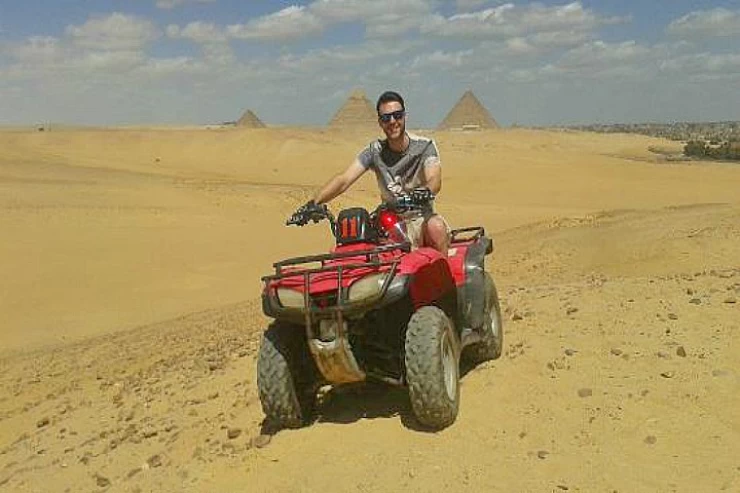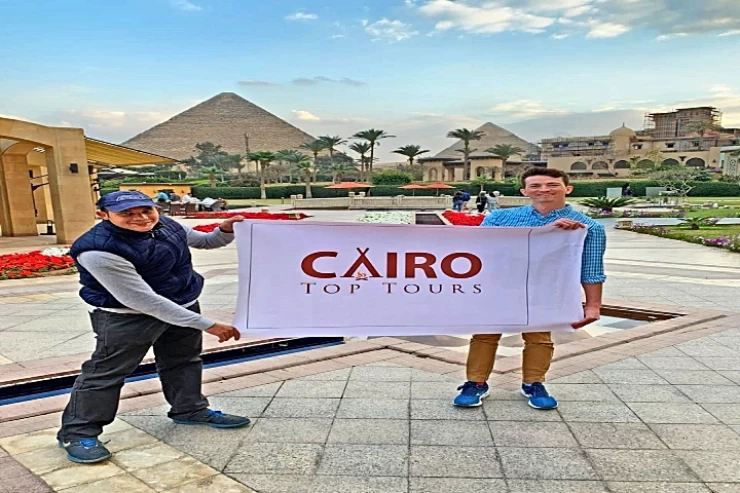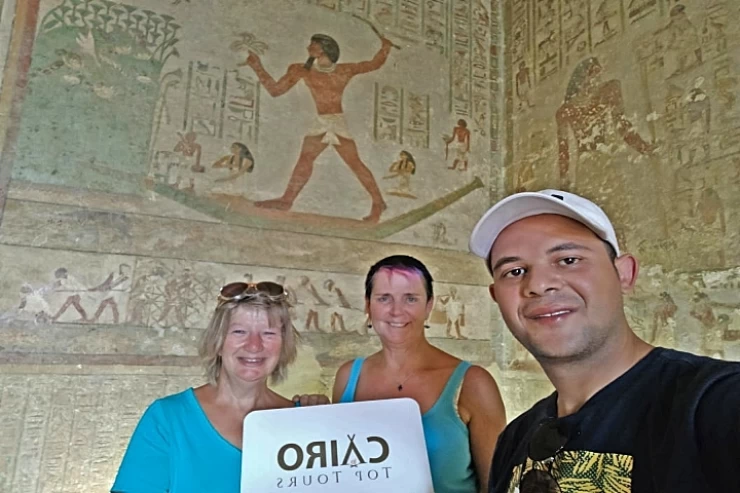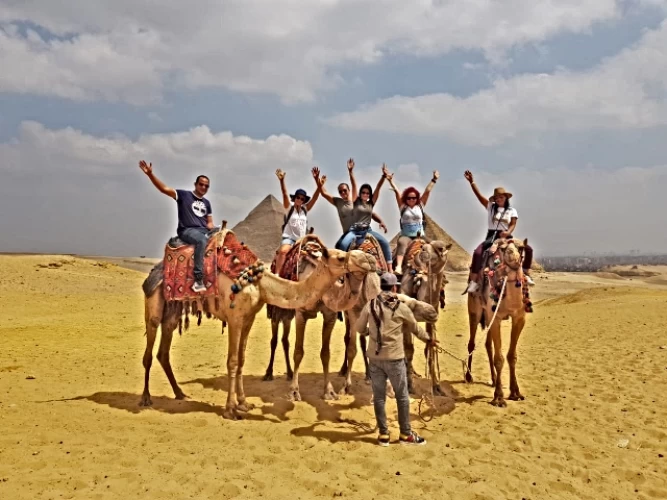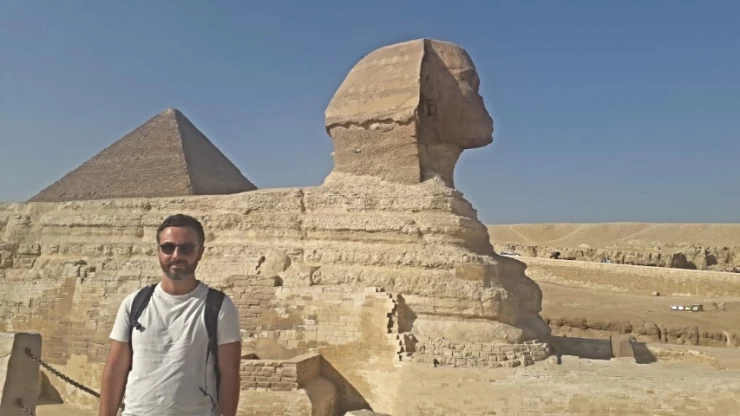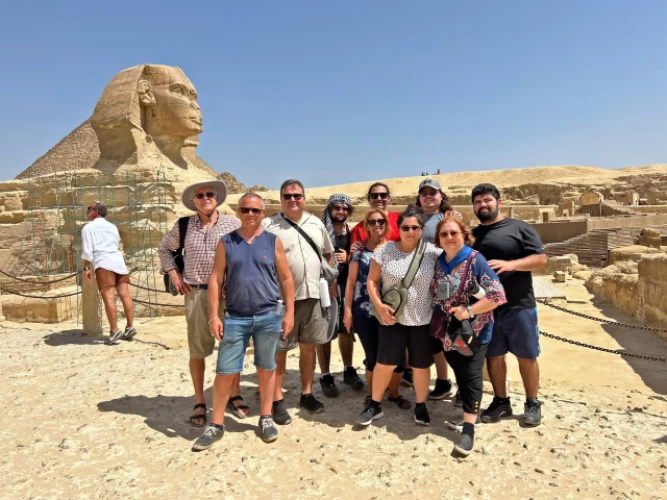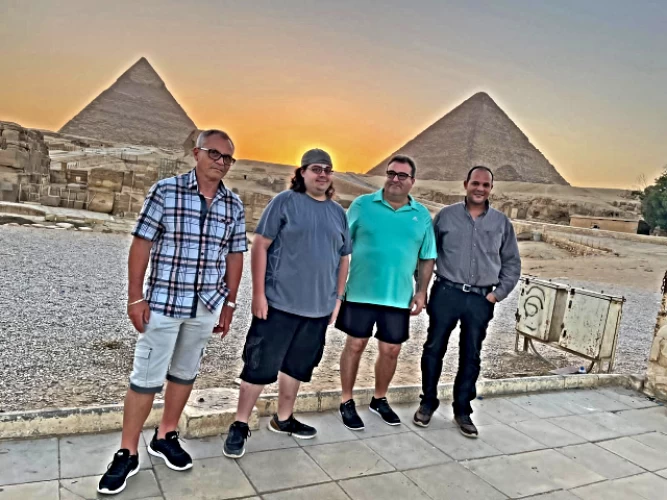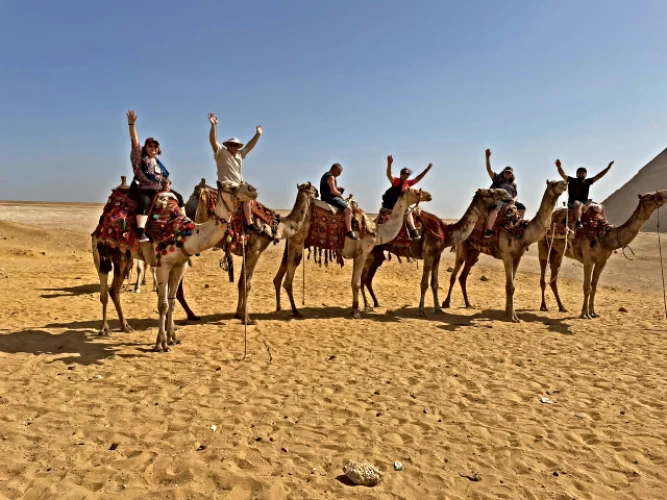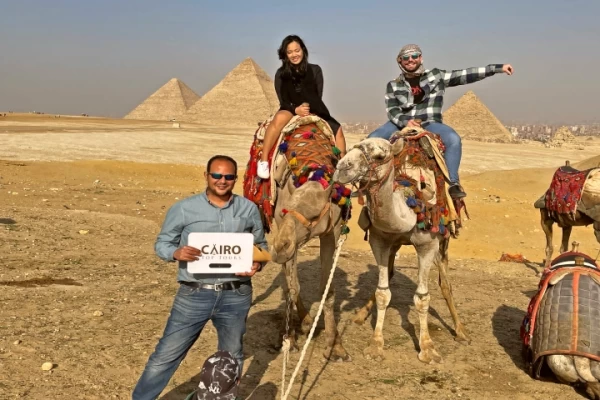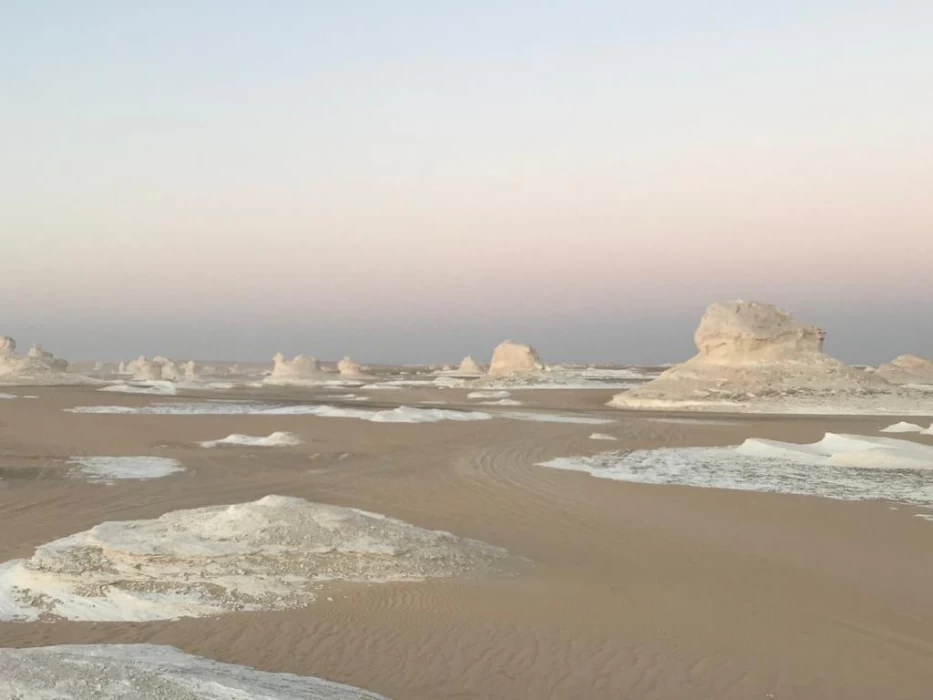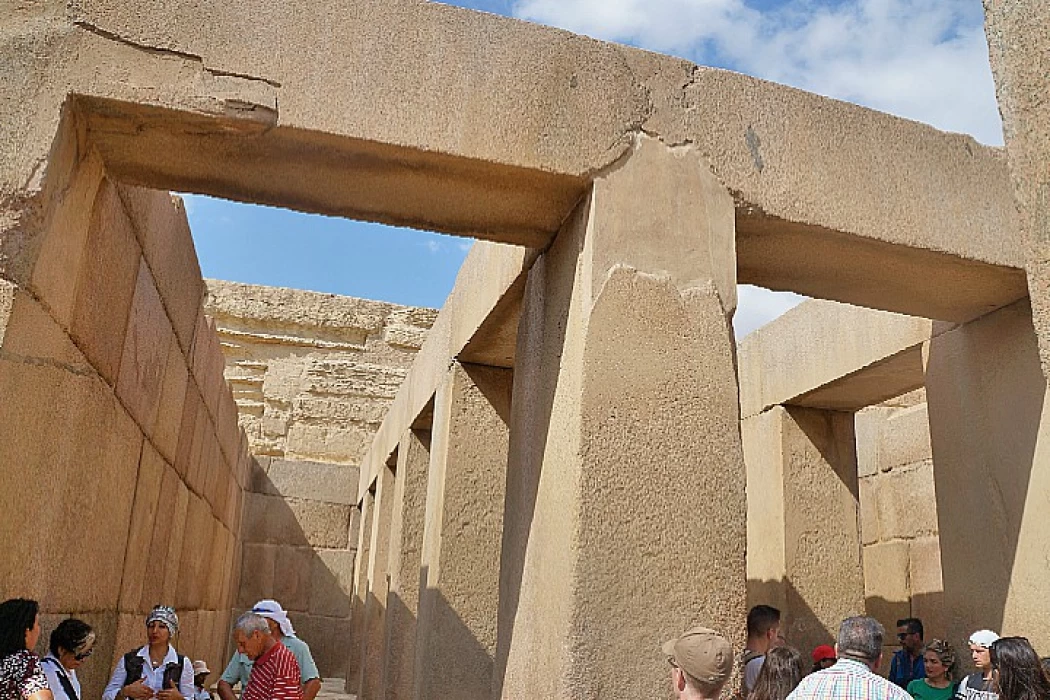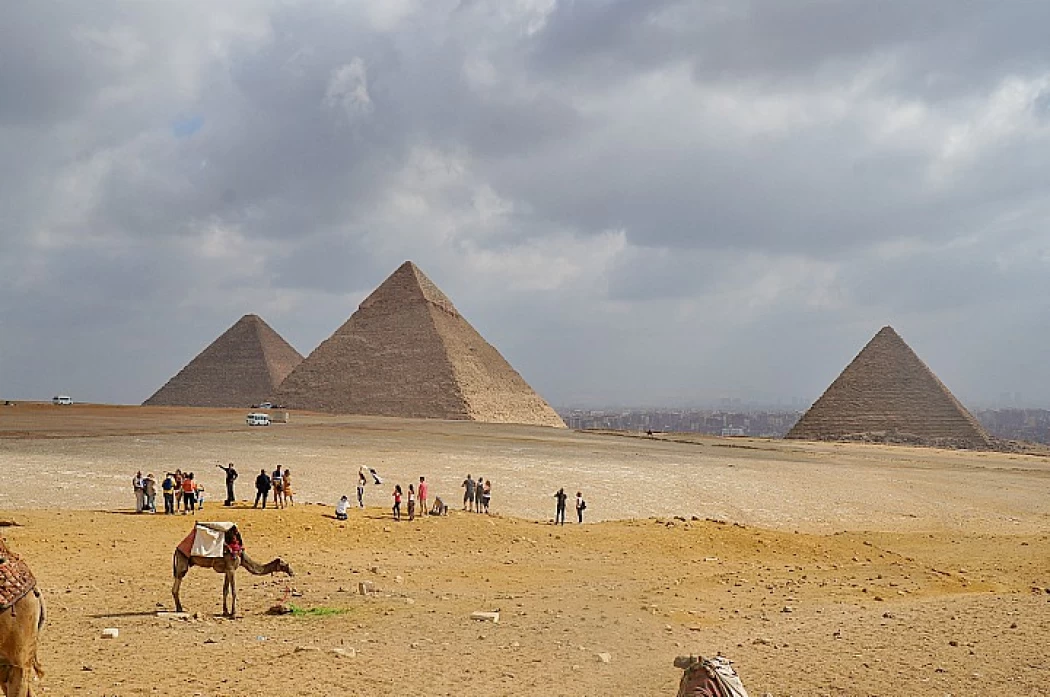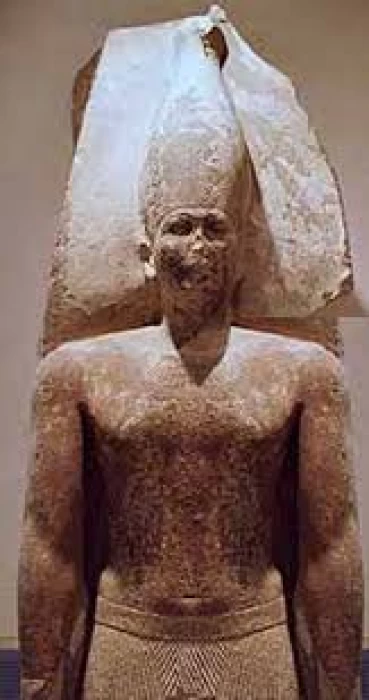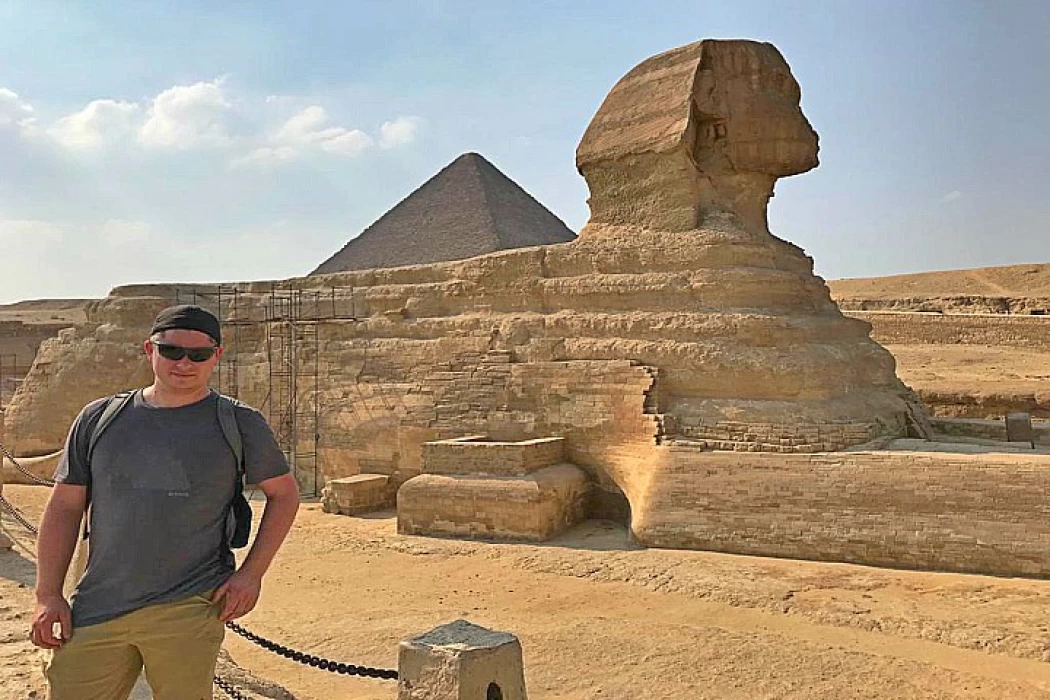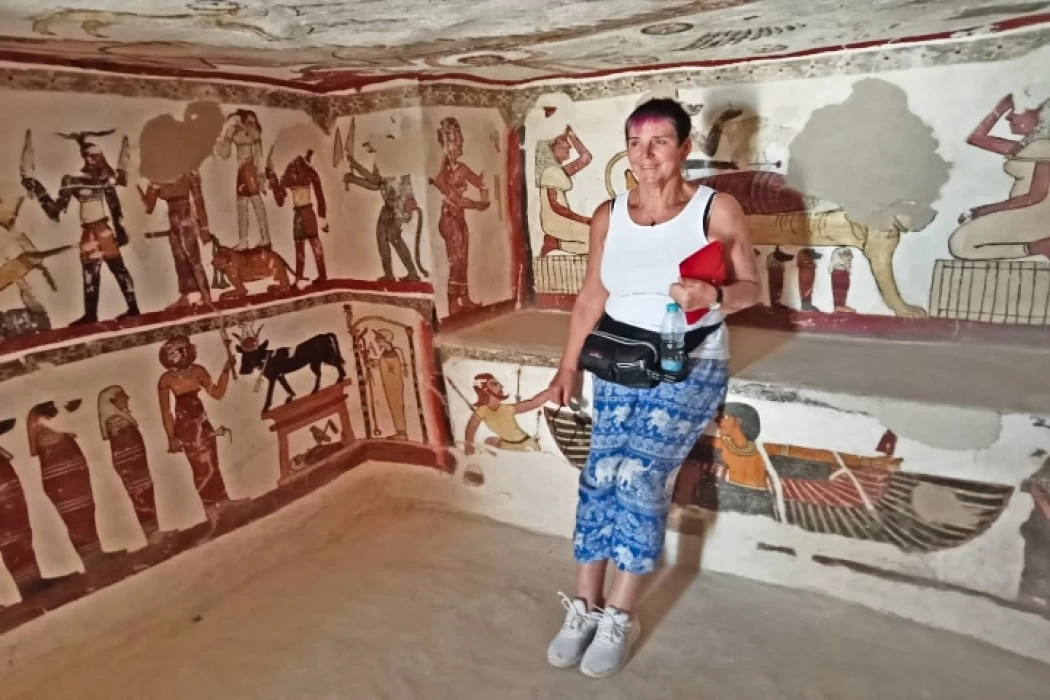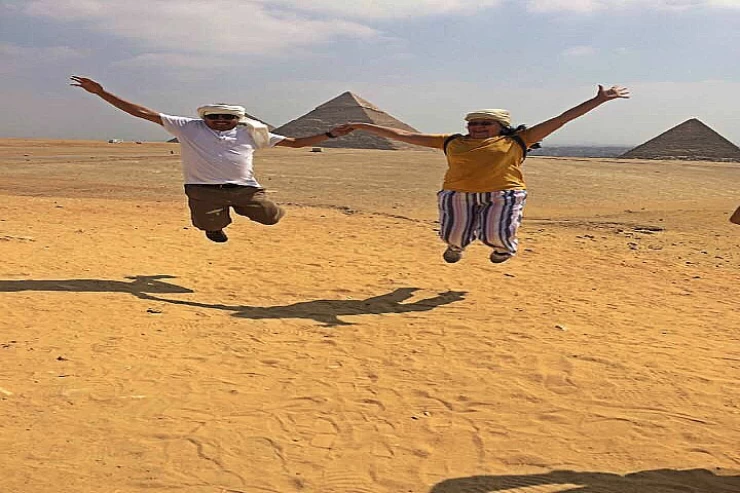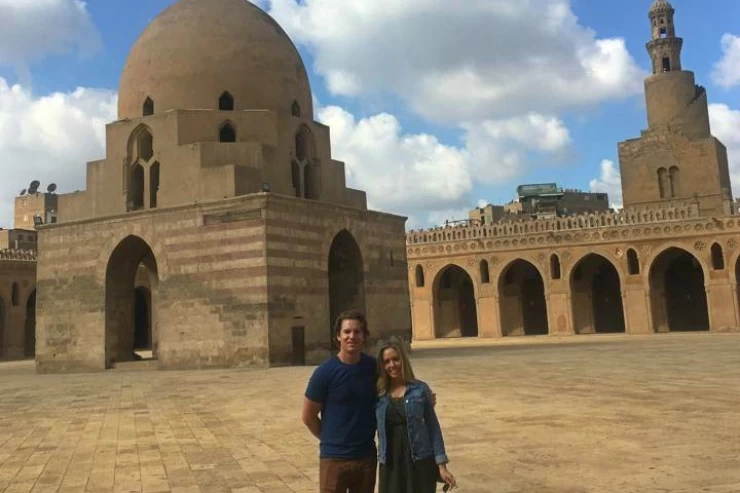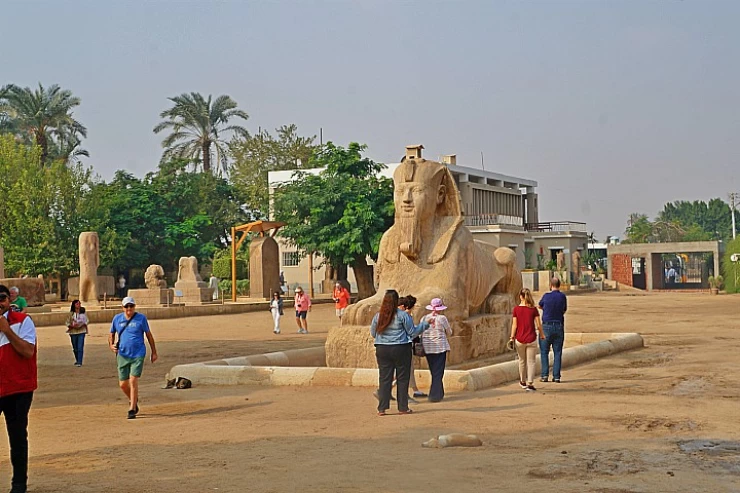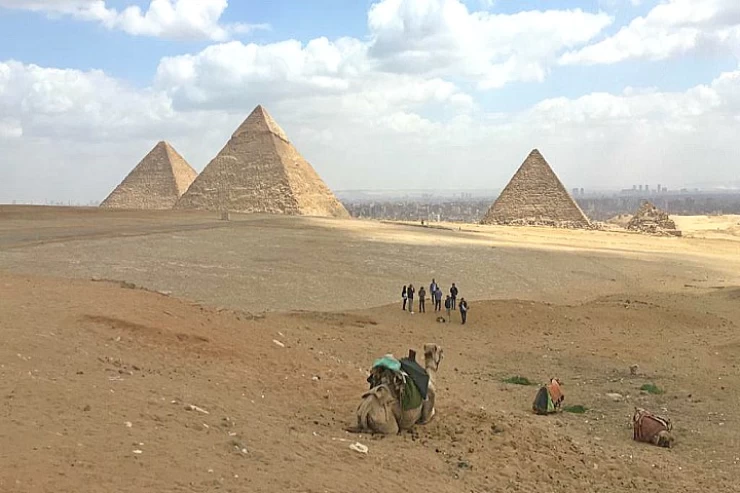Quad Biking Desert Safari tour around the Pyramids
Overview
Embark on an exhilarating adventure during your Cairo day tour with the Quad Bike Desert Safari. This thrilling experience takes you on a journey around the majestic Pyramids of Giza, allowing you to immerse yourself in the captivating view of these iconic historical wonders.
Hop on a quad bike and feel the excitement as you navigate the desert terrain, taking in the breathtaking sights of the Cheops, Chephren, and Mycerinus pyramids. These monumental structures, built by the legendary kings and rulers of the 4th dynasty, stand tall as a testament to the ingenuity and skill of ancient Egyptian builders.
This Egypt Tours package offers an unparalleled opportunity for adventure seekers and explorers to delve into the desert surrounding the pyramids. Discover the renowned Mycerinus pyramids up close and personal, and create unforgettable memories during your Egypt trip.
In addition to the thrilling Quad Bike Desert Safari, there's so much more to explore in this captivating country. Take in the breathtaking sights of the Alabaster Sphinx of Memphis, a stunning and awe-inspiring ancient Egyptian landmark. Egypt's rich history and stunning natural beauty draw visitors from around the world, eager to uncover the secrets of this remarkable destination.
Embark on an exhilarating adventure during your Cairo day tour with the Quad Bike Desert Safari. This thrilling experience takes you on a journey around the majestic Pyramids of Giza, allowing you to immerse yourself in the captivating view of these iconic historical wonders.
Hop on a quad bike and feel the excitement as you navigate the desert terrain, taking in the breathtaking sights of the Cheops, Chephren, and Mycerinus pyramids. These monumental structures, built by the legendary kings and rulers of the 4th dynasty, stand tall as a testament to the ingenuity and skill of ancient Egyptian builders.
This Egypt Tours package offers an unparalleled opportunity for adventure seekers and explorers to delve into the desert surrounding the pyramids. Discover the renowned Mycerinus pyramids up close and personal, and create unforgettable memories during your Egypt trip.
In addition to the thrilling Quad Bike Desert Safari, there's so much more to explore in this captivating country. Take in the breathtaking sights of the Alabaster Sphinx of Memphis, a stunning and awe-inspiring ancient Egyptian landmark. Egypt's rich history and stunning natural beauty draw visitors from around the world, eager to uncover the secrets of this remarkable destination.
Inclusion
- Private vehicle from your hotel by Cairo Top Tours to the quad bike Centre and return.
- Quad bike ride in Giza Pyramids for about 2 hours with the Pyramid's view in the background.
- Transfers are done privately using an air-conditioned vehicle during all Egypt Day Trips.
- All taxes and service charges of your Cairo Day tours are covered.
- Free bottle of water on your way to starting your quad biking trip in Giza Pyramids.
Exclusion
- Any extras not specified in our programs.
- Tipping for the staff during Egypt tours is not included in the prices of the tours in Cairo.
- Prices are valid during Christmas and New Year tours in Egypt or Egypt Easter tours.
Itinerary
Experience your thrilling Quad Bike Desert Safari adventure in the afternoon or at a time that suits you best. A knowledgeable representative from Cairo Top Tours will meet you at your hotel in Cairo or Giza and escort you to the quad bike center, where you'll be introduced to your experienced Bedouin guide.
Before setting off, you'll receive a brief safety orientation and instructions on operating the quad bikes. Then, it's time to ignite the engines and follow your guide on a captivating journey around the Pyramids of Giza. Carve through the desert landscape for an exhilarating one-hour ride, taking in the breathtaking sights of the ancient wonders.
Admire the towering Cheops (also known as Khufu), Chephren, and Mycerinus pyramids, each a testament to the ingenuity and craftsmanship of Egypt's ancient builders. Your local guide will be on hand to help you capture the most stunning photographs, ensuring you have lasting memories of this unforgettable adventure.
After your thrilling quad bike excursion, you'll have a one-hour break to rest and refresh before continuing your exploration. Upon your return, you'll have the opportunity to use the restroom and wash up, making this Cairo excursion a truly memorable and well-rounded experience.
Go on your incredible ATV adventure this afternoon or whenever it suits your schedule best. A friendly representative from our team will meet you directly at your hotel in Cairo or Giza and escort you to the quad bike center, where you'll be introduced to your knowledgeable Bedouin guide who will accompany you throughout the tour.
Before setting off, we'll provide you with a brief orientation and instructions on safely operating the ATVs. Then, it's time to rev up your engines and follow your guide on an exhilarating journey around the legendary Pyramids of Giza. As you traverse the desert terrain, you'll have the unique opportunity to explore these ancient wonders up close, learning about the captivating history and achievements of the pharaohs who built them.
Your local guide will be on hand to ensure you capture the most breathtaking photos, allowing you to immortalize the stunning vistas and cherish the memories of this unforgettable adventure for years to come. After your initial thrilling ATV ride, you'll have a well-deserved one-hour break to rest and recharge before continuing your exploration.
Once your tour concludes, we'll transport you back to your hotel, ensuring a seamless and convenient experience from start to finish.
Price
| Number of Persons | Prices |
|---|---|
| 1 Person | $75 Per Person |
| 2 - 3 Persons | $60 Per Person |
| 4 - 6 Persons | $50 Per Person |
| 7 - 10 Persons | $40 Per Person |
Start from : $35
Check Availability
Related Articles

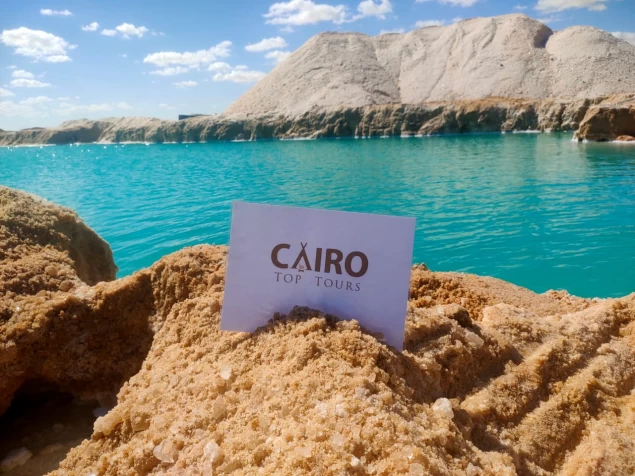
You Also May Like
Looking for something different? check out our related tour now, or simply contact us to tailor made your Egypt tour
Tour to Giza Pyramids and the Egyptian Museum in Cairo
Make sure you seize the opportunity to be among the initial explorers of the recently uncovered secret passage inside the Great Pyramid of Giza. Experience the wonders of the world, including the Sphinx and the three famous pyramids. Also, during our day trip to Cairo, you'll have the chance to admire the incredible ancient artefacts at the Egyptian Museum.
Tour to the Egyptian Museum, Old Coptic and Islamic Cairo
Explore the significance of Cairo by visiting the Egyptian Museum and admiring its impressive exhibits. You can also explore the renowned landmarks and churches of Coptic Cairo, which once housed the Holy Family and showcase unique icons. Furthermore, enjoy exploring the historic mosques of Islamic Cairo during your trip to Old Cairo.
Cairo Excursions to Giza pyramids, Sakkara and Memphis
With our extraordinary Giza pyramids, Sakkara and Memphis Tour witness the iconic pyramids of Giza and marvel at the magnificence of Egyptian pharaohs. Explore Egypt's ancient capital, adorned with a plethora of pyramids and tombs, and uncover hidden mysteries during your excursion in Cairo.
Cairo Stopover Transit Tour | Cairo Layover Tour
Embark on a thrilling journey through the ages as you explore the wonders of ancient Egypt. Begin your adventure at the iconic Giza Pyramids, marveling at the engineering feats and architectural mastery of these legendary structures. Next, delve into the extraordinary collection of artifacts housed within the Egyptian Museum in Tahrir Square.
Egypt Trips and Middle East Reviews
We received a lot of positive feedback from our customers about Egypt budget tours with Egypt Tours, which you can see on our social media pages, such as Trip Advisor, and YouTube videos. Our experts stay with travelers to every part of Egypt to explain to them the historical background of every site they see while they are on their Egypt and Holy Land tours.
Egypt is an important country with many amazing things to see. If you want to experience all the best parts, like the Giza Pyramids, and even go on a fun quad biking tour around them, it's a good idea to join a guided tour that lasts for several days. This way, you can make sure you see all the most interesting places in this fascinating country and don't miss out on anything exciting.
Visiting Egypt allows one to submerge in profound antiquity. To optimize each moment, accompany an organized several-day excursion. This technique guarantees encounters with legendary places such as the King's Hollow and Giza's renowned pyramids. Escorts seamlessly handle movement between spots while imparting contextual insights.
Participation requirements and restrictions for quad biking (four-wheel-drive) tours in the desert around the Pyramids can vary depending on the tour operator and location. However, it's essential to consider the following points:
Age Restrictions: Many tour operators have age restrictions for quad biking participants. The minimum age to ride a quad bike is typically around 16 to 18 years old. Younger participants may need to be accompanied by a legal guardian or parent.
Driving License: In some cases, participants may be required to hold a valid driver's license, even for off-road vehicles like quad bikes. Check with the tour operator regarding this requirement.
Skill Level: While no specific driving skills are usually required, it's essential to be physically capable of operating a quad bike safely. Some tour operators provide brief training sessions or safety instructions before the ride, ensuring that participants understand how to operate the vehicles.
Safety Gear: Tour operators often provide safety gear, including helmets and goggles, to all participants. It's essential to wear the provided safety gear during the ride for your protection.
Waivers and Release Forms: You may be asked to sign a waiver or release form acknowledging the risks associated with quad biking. Read and understand the terms and conditions before signing.
Health Considerations: Inform the tour operator if you have any medical conditions, physical limitations, or allergies that could affect your ability to participate safely. They can provide guidance based on your specific circumstances.
Supervision: If you're traveling with children or teenagers, ensure that they are supervised during the quad biking experience and comply with any age and safety requirements set by the tour operator.
Yes, you can book a day tour to explore Islamic Cairo and its historic sites. Islamic Cairo is a fascinating area of the city with a rich history and numerous landmarks, including mosques, madrasas (Islamic schools), markets, and more. Here's a suggested itinerary for a day tour of Islamic Cairo:
Morning:
Visit the Saladin Citadel: Start your day with a visit to the Saladin Citadel, a UNESCO World Heritage Site, and explore its iconic landmarks, including the Mosque of Muhammad Ali (Alabaster Mosque) and the impressive views of Cairo from the citadel's walls.
Mid-morning: 2. Al-Muizz Street: Take a stroll along Al-Muizz Street (Al-Muizz li-Din Allah al-Fatimi Street), one of the most historic streets in Cairo. It's lined with beautifully preserved medieval Islamic architecture, including mosques, palaces, and shops. You can explore sites like the Sultan Hassan Mosque and the Al-Azhar Mosque.
Lunch: 3. Lunch in Islamic Cairo: Enjoy lunch at a local restaurant in Islamic Cairo, where you can savor traditional Egyptian dishes.
Afternoon: 4. Khan El Khalili Bazaar: Visit the Khan El Khalili Bazaar, one of the oldest and most vibrant markets in Cairo. You can shop for souvenirs, jewelry, textiles, spices, and more.
Mosque of Ibn Tulun: Explore the historic Mosque of Ibn Tulun, known for its unique architectural design and large open courtyard.
Gayer-Anderson Museum: Optionally, you can visit the Gayer-Anderson Museum, a well-preserved historic house that provides insight into the lifestyle of a wealthy Egyptian family in the 17th century.
Late Afternoon: 7. El Azhar Park: If time allows, you can end your day by visiting El Azhar Park, a beautiful green oasis in the heart of Islamic Cairo, offering a tranquil escape with scenic views.
Cairo Day Tours offer the opportunity to visit a wide range of attractions and landmarks in and around the city. The specific attractions included in a tour can vary depending on the type of tour and the tour operator, but here are some of the most common attractions that you can visit during Cairo Day Tours:
Giza Pyramids: The Great Pyramids of Giza, including the Pyramid of Khufu, the Pyramid of Khafre, and the Pyramid of Menkaure, are iconic attractions and are often a focal point of many tours.
The Sphinx: Adjacent to the pyramids, the Great Sphinx of Giza is another must-see attraction.
Egyptian Museum: Located in Cairo, this museum houses a vast collection of ancient Egyptian artifacts, including the treasures of Tutankhamun.
Cairo Citadel: A historic Islamic fortification, the Cairo Citadel offers panoramic views of the city and includes the impressive Mosque of Muhammad Ali.
Khan El Khalili Bazaar: Cairo's most famous market, where you can shop for souvenirs, jewelry, spices, and more.
Coptic Cairo: Explore the historic Christian quarter of Cairo, including the Hanging Church, St. Sergius and Bacchus Church, and the Coptic Museum.
Islamic Cairo: Visit mosques, madrasas, and historic Islamic landmarks in the older part of the city.
Nile River Cruises: Enjoy a scenic cruise along the Nile River, often offered as an optional activity.
Al-Azhar Park is a beautiful park in the heart of Cairo, offering greenery and stunning views of the city.
Al-Muizz Street: Known for its historic architecture and landmarks, this street is a UNESCO World Heritage Site.
Salah El-Din Square: A central square with the Saladin Citadel and the National Military Museum
Koubbeh Palace: A former royal palace with architectural significance
Al-Hakim Mosque: A unique Fatimid-era mosque
Ben Ezra Synagogue: A historic synagogue in Coptic Cairo
Karnak House: A cultural center offering insights into Egyptian heritage
The Pharaohs of ancient Egypt used a distinctive color palette and a variety of symbols in their art and decoration. These colors and symbols held significant cultural and religious meanings. Here are some of the key colors and symbols used by the Pharaohs:
Colors:
Red: Red was associated with chaos and disorder, as well as fire and destruction. It was also linked to the god Seth. Red was sometimes used for the bodies of enemies in military scenes.
Yellow/Gold: Yellow and gold represented the sun and its life-giving properties. They were associated with the sun god Ra. Gold was often used for hieroglyphs and jewelry to signify their divine nature.
Blue: Blue symbolizes the sky and the heavens. It was also associated with the Nile River, which was central to Egyptian life. Blue was used for jewelry, cosmetics, and amulets.
Green: Green was linked to fertility and regeneration. It was associated with Osiris, the god of the afterlife. Green was used in depictions of vegetation and rebirth.
White: White was a symbol of purity and cleanliness. It was associated with the goddess Isis and was commonly used in religious rituals and funerary art.
Black: Black was associated with death and the underworld. It represented the fertile black soil of the Nile and was used in the context of rebirth and regeneration.
Brown: Brown was often used for background colors and for depictions of deserts and barren land.
Symbols:
Ankh: The ankh, a cross with a loop at the top, represents life and immortality. Gods and Pharaohs often carried it, and it is one of the most recognizable symbols from ancient Egypt.
Eye of Horus: The Eye of Horus, an ancient Egyptian symbol of protection, royal power, and good health, was frequently used in amulets and jewelry.
Scarab Beetle: The scarab beetle symbolized transformation, protection, and regeneration. It was associated with the sun god Ra and was often used in amulets and jewelry.
Lotus Flower: The lotus flower represents rebirth and creation. It was a common motif in art and architecture, symbolizing the cycle of life and death.
Wadjet (Uraeus): The cobra symbol, known as the Uraeus, represented protection and divine authority. It was worn on the pharaoh's crown to signify their power.
Cartouche: A cartouche was an oval frame that enclosed the name of a pharaoh. It served as a protective device, preserving the pharaoh's name for eternity.
Sistrum: The sistrum, a musical instrument, was a symbol of joy, music, and worship. It was often used in religious rituals.
The best places for shopping in Cairo include Khan El Khalili, The Friday Market, City Stars Mall, Mall of Arabia, and Tahrir Square.
There are usually some basic requirements to participate in a quad biking trip in the desert, including:
Suitable age.
Driving License.
Basic training.
Appropriate clothing.
good health.
Yes, many Cairo tours include time for shopping in the local markets. These markets are a great opportunity to discover local culture and buy souvenirs or local handmade products.
Local markets in Cairo are available in different forms, such as:
Khan Al-Khalili: It is considered one of the oldest markets in Cairo, and includes many shops selling carpets, traditional weaving, handicrafts, and more.
Old Khan Al Khalili Market: Offers a unique experience with narrow alleys and traditional shops selling local products and handicrafts.
Central Market (Egyptian Museum of Modern Civilization): It includes many shops that sell modern products and souvenirs related to modern Egyptian culture.
Visiting the pyramids in Egypt often includes several tourist areas in Cairo. The three pyramids at Giza are the main pyramids and are considered part of an important archaeological site. Here is a list of areas you may visit during your pyramid tour:
Giza Pyramids:
Pyramid of Khufu (Cube).
Khafre's Pyramid (Kafrin).
Menkaure's Pyramid (Menkaure Ra).
Desert pyramids:
Giza plateau.
A Quad Biking Desert Safari is an adventure activity where participants ride quad bikes (ATVs) through the desert terrain, typically guided by experienced instructors. It offers a thrilling experience combined with the natural beauty of the desert landscape.
The duration of a Quad Biking Desert Safari around the Pyramids can vary depending on the specific tour or package you choose. Typically, the experience lasts around 1-2 hours, including the time for safety briefings, equipment setup, and the actual quad biking adventure. It's important to check with the tour operator or service provider for the precise duration of the activity.
Children over the age of 12 are permitted to drive alone, while those under the age of 12 must ride in a quad with an adult; in this scenario, the youngster will travel free of charge.


Cairo Top Tours Partners
Check out our partners

